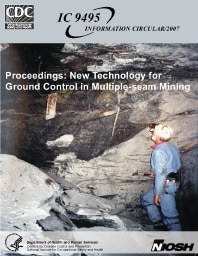Mining Publication: Multiple-Seam Mining Interactions: Case Histories from the Harris No. 1 Mine
Original creation date: May 2007
Authors: FE Chase, P Worley, C Mark
NIOSHTIC2 Number: 20032067
Proceedings: New Technology for Ground Control in Multiple-Seam Mining. Mark C; Tuchman RJ, eds., Pittsburgh, PA: U.S. Department of Health and Human Services, Public Health Service, Centers for Disease Control and Prevention, National Institute for Occupational Safety and Health, DHHS (NIOSH) Publication No. 2007-110, IC 9495, 2007 May; :63-71
The Harris No. 1 Mine in Boone County, WV, has been longwalling the Eagle Coalbed for over 30 years. Harris has experienced numerous interactions associated with the extensive room-and-pillar and longwall mining operations that have been conducted in the overlying No. 2 Gas Coalbed. The problems have included roof falls, excessive rib sloughage, and gate road and bleeder entry closure. A detailed evaluation of the multiple-seam experiences at Harris No. 1 Mine was done as part of NIOSH's nationwide multiple-seam mining case history database. One observation was that smaller, critically loaded, upper-seam pillars seemed to cause more severe ground conditions than wider pillars. The LaMODEL program was used to investigate this. Results confirmed that critical-sized pillars transmit the highest amounts of stress to adjacent seams. In addition, the data suggest that the probability of a major multiple-seam mining interaction increases when the depth of cover is 1,000 ft or greater and when the Eagle Seam pillars have an ALPS stability factor of less than 1.50.

NIOSHTIC2 Number: 20032067
Proceedings: New Technology for Ground Control in Multiple-Seam Mining. Mark C; Tuchman RJ, eds., Pittsburgh, PA: U.S. Department of Health and Human Services, Public Health Service, Centers for Disease Control and Prevention, National Institute for Occupational Safety and Health, DHHS (NIOSH) Publication No. 2007-110, IC 9495, 2007 May; :63-71
- Behavior of a Coal Pillar Prone to Burst in the Southern Appalachian Basin of the United States
- Field Observations and Numerical Studies of Horizontal Stress Effects on Roof Stability in U.S. Limestone Mines
- The Ground Response Curve, Pillar Loading and Pillar Failure in Coal Mines
- Knowledge Management and Transfer for Mine Emergency Response
- Multiple Seam Mining Interactions: Case Histories from the Harris No. 1 Mine
- Pillar Stability Issues Based on a Survey of Pillar Performance in Underground Limestone Mines
- Proceedings: New Technology for Ground Control in Multiple-seam Mining
- Reducing the Risk of Ground Falls During Pillar Recovery
- Sizing of Final Stumps for Safer Pillar Extraction
- Stability Analysis of a Backfilled Room-and-Pillar Mine